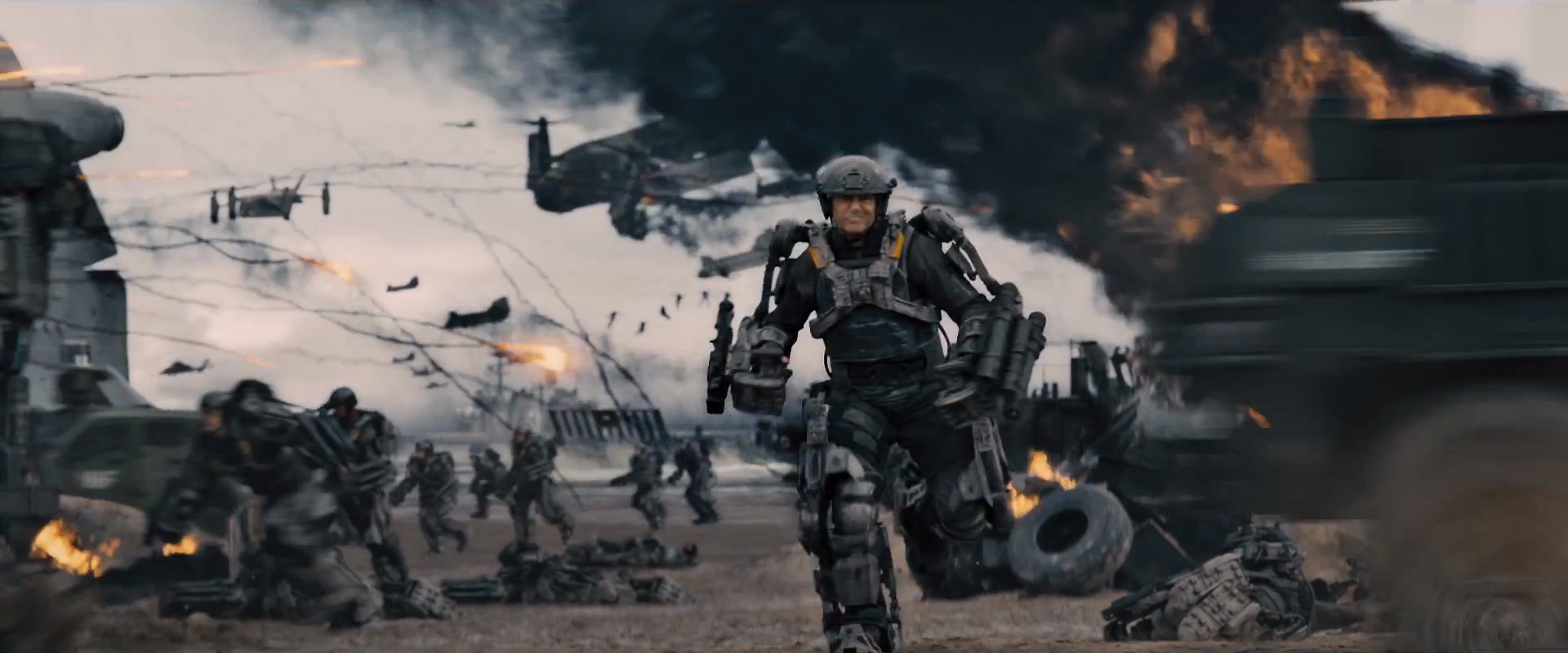Tomorrow Has An Edge – And It’s Blunt!
 Take equal parts Groundhog Day and Starship Troopers, subtract all of the satire and most of the humour, and add two dashes of charismatic star power, and you’ve got Edge of Tomorrow, a thoroughly solid and entertaining (if not particularly groundbreaking) take on the classic science-fiction “repeating day” trope.
Take equal parts Groundhog Day and Starship Troopers, subtract all of the satire and most of the humour, and add two dashes of charismatic star power, and you’ve got Edge of Tomorrow, a thoroughly solid and entertaining (if not particularly groundbreaking) take on the classic science-fiction “repeating day” trope.
And as repeating days go, this one’s a doozy. For starters, It involves a terrifying alien horde, a badass war hero, a scrappy group of ne’er-do-well grunts, a trip to various European locales, Bill Paxton (!), and a beach invasion that recalls the D-Day sequence from Saving Private Ryan, only with troops in robotic battle armour substituted for the Allies, and bizarre, techno-Lovecraftian nightmares[1] in place of the Nazis.[2]
The advertisements tout the film as being from the director of The Bourne Identity and Mr. and Mrs. Smith, and I’m happy to say that Doug Liman’s sense of geography and choreography within an action scene is only getting better. The aforementioned D-Day homage (one of many WW2 references) is appropriately chaotic without being confusing—Liman effectively communicates the harrowing sense of being in the middle of a frenetic battle, and yet you never lose track of where anything or anyone is, or what’s going on. It sounds like basic filmmaking 101, but I’m consistently disheartened at how many well-established and successful directors completely whiff it when it comes to this sort of thing, and so I want to give credit where it’s due.

Edge of Tomorrow is a well-made movie. It’s well written—the dialogue never sounds hammy or unrealistic (the fantastic cast helps, I’m sure); it has a solid, clever, tightly-plotted story structure, and it’s quite well-shot. It’s not reinventing the wheel or anything, but it doesn’t need to. This is a sci-fi action potboiler without any grand ambitions of anything meaningful, and as such, it does what it’s doing perfectly well.
Tom Cruise is Lt. Col. Bill Cage, a sleazy, spineless ad man who makes Don Draper look like William Wallace. When war breaks out with an invading alien species (nicknamed “Mimics” because of their ability to anticipate and copy our attack patterns), he’s drafted back into service thanks to the ROTC he did as a kid. Cage is no kind of combat material, but his silver tongue makes him invaluable in selling the war to a cynical public. But when he crosses the wrong general (Brendan Gleeson), he’s dropped headlong into the thick of the shit, as it were. Through a freak happenstance, Cage then finds himself trapped in a time loop, living out the worst day of his life over and over and over again. Every time he dies (which happens a lot), he resets—or to use video game parlance—he respawns.
This is actually a very appropriate way to describe the story structure of the film.
Like a lot of 21st-century action cinema, Edge of Tomorrow is very much a video-game inspired movie. Cage is essentially a “n00b” whose life has suddenly been set to the highest difficulty level, with nary a tutorial to guide him. And since quitting or playing a different game isn’t an option, he basically has to just keep trying over and over again, getting a little bit better at survival each time.
(An aside: while I understand the need for a more accessible PG-13 rating in order to sell more tickets, I can’t help but wonder how much more fun a really gory R-rated version would have been, where we’d actually get to see all the icky-sticky details of Cage’s various demises through creative practical effects).
I’m not sure how action games work nowadays, but back in my time the way you got better at a video game was by learning the game’s patterns: jump here, duck there, wait for the fireball to pass, remember when the boss jumps this way or that way, up, up, down, down, left, right, left, right, B, A. Well, that’s essentially what Cage does—through day after repeating day of trial and error (where error means a gruesome and painful death), he memorizes the pattern, learning when to jump and duck and dodge, and where any given Mimic will be at any given moment. Each day is a chance to level up, and that’s what gets him on the radar of the high-scoring, leading champion. This is Rita Vrataski (Emily Blunt), known to the world as the “Angel of Verdun,” and to her fellow soldiers, more colloquially as the “Full Metal Bitch.” Vrataski is a superstar soldier who has singlehandedly killed hundreds of Mimics. Subsequently, the United Defense Force has co-opted her image as their single biggest tool for recruitment. Her intimidating visage, clad in her prototype “jacket” (a powered combat exoskeleton), and brandishing her signature weapon (a massive battle sword not unlike that of Final Fantasy VII’s Cloud Strife [yet another video game reference]), glares down from massive posters on the sides of buses and buildings, rallying new recruits to the war effort.

As it turns out, Vrataski’s Mimic-fragging skillz came from leveling up the same way Cage did—until one day she lost her infinite lives cheat code—something that could happen to Cage too, if he isn’t careful. So now it’s up to Vrataski to train her successor, and maybe they have a chance at winning the war.
Tom Cruise and Emily Blunt are terrific in these roles. Cruise effortlessly channels his star quality into every aspect of Cage’s development, from hapless coward to conquering hero, parlaying his natural likability first into an oily smarminess, later into conflicted vulnerability, and finally into heroic courage. But we’re used to all that—after all, Cruise is one of the last big movie stars, and has given consistently great work over the course of the last few decades. At this point, the surprise would be if he phoned it in. Honestly, I’m more excited about Emily Blunt, whose star has been on the rise for the last few years, and who is, in my opinion, one of the most exciting young actresses around—someone who possesses real star quality—when she goes toe-to-toe with a heavyweight like Cruise and still manages to outshine him—that’s something to get excited about.

Blunt’s Rita Vrataski is probably one of my favourite movie characters of the year. She’s a tough-as-nails warrior who also happens to be a woman. She isn’t defined by her gender, yet she’s also totally feminine at the same time. She’s a heroine in the grand tradition of Ellen Ripley, Sarah Connor, Buffy Summers and Alice Abernathy—simultaneously hardened and vulnerable; effortlessly sexy without being obvious or seductive.[3]
Emily Blunt is one of those rare actors who is able to layer multiple emotions on top of each other in a single performance. Every line delivery, facial expression, and aspect of her body language communicates on multiple levels.
There’s courageous resignation layered on top of determination, layered on top of anger, which in turn is masking a sense of sadness, coming from a place of regret in the face of loss; all built on a foundation of fear. Blunt gives Vrataski a real, nuanced, human psyche that a lesser actress would never be able to match. This is why Emily Blunt tends to elevate everything she’s in. Much like Eva Green did for 300: Rise of an Empire earlier this year, Blunt takes this game to a whole ‘nother level.
Even though she missed the opportunity to join the Marvel Cinematic Universe as Black Widow, thanks to Gulliver’s Travels running over-schedule (not that I’m complaining about Scarlett Johansson—another fantastic actress), Edge of Tomorrow is her biggest movie yet, and if for no other reason, I want it to be successful so that we can continue to see Emily Blunt in bigger and bigger roles. I’m not sure if the movie deserves to be a Godzilla-sized hit, but she’s earned her stripes regardless.
[1] I have to take a moment to praise the design of the Mimics. They’re like semi-autonomous ganglions that become nearly formless in motion. While they’re not especially exciting to look at while standing still, the way they move is fantastic—a lightning-fast undulation of endless tendrils that seems to be happening in some sort of different timeframe (Warning! Spoiler area! To read click here!) from the rest of reality. Fortunately, we almost always see them in churning locomotion, and it’s terrifying.
[2] Thankfully, there’s no obligatory seduction-leading-to- sex scene, the likes of which can be a little slightly-rapey-creepy if you think too hard about the implications thereof (does consent really exist when you get endless do-overs until you can learn exactly how to seduce someone?).
[3] In other words, her sexiness comes from a place of capable strength and confidence, not from any sense of exploitation—if I recall correctly, she barely shows any excess skin (she’s mostly in her combat jacket the whole film)—and the one time we see her in a tank top, she isn’t even showing any cleavage.

